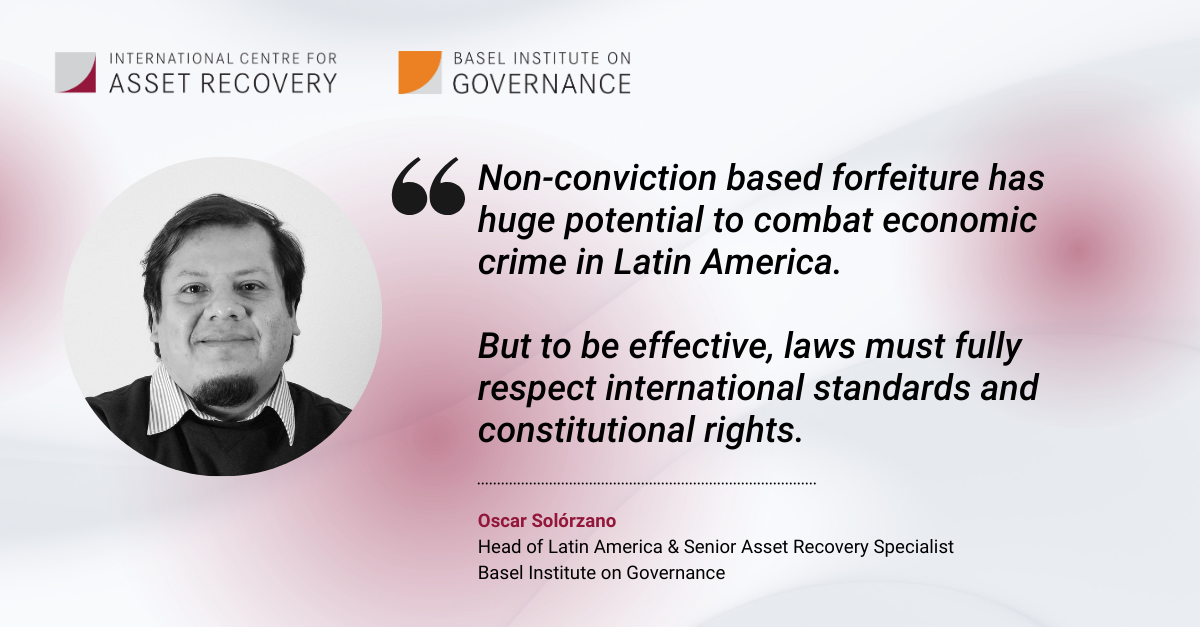New GAFILAT guide: Why asset recovery laws need to align with human rights and other international standards

A new guide to non-conviction based forfeiture published by GAFILAT, the Latin American body of the Financial Action Task Force (FATF) sets out good practices for this powerful but under-used form of asset recovery legislation. It also emphasises the need for laws to align with both domestic constitutions and international human rights standards.
The GAFILAT guide was drafted by Oscar Solórzano in collaboration with the region’s Asset Recovery Network (RRAG). Oscar is Head of Latin America at the Basel Institute on Governance and a Senior Asset Recovery Specialist with many years of experience supporting government partners across Latin America in high-profile, complex cases of corruption and asset recovery.
In this Q&A, he explains the approach, relevance and impact of the Guía de Buenas Prácticas sobre Extinción de Dominio y Decomiso no Basado en Condena, which was published by GAFILAT in 2024 and financed by EU member states through the COPOLAD III cooperation programme. COPOLAD III is a consortium led by the Italo-Latin American Association (IILA) and FIIAPP of the Spanish Cooperation.
1. What is the guide about and who is it for?
This is a guide to good practices in non-conviction based forfeiture for Latin America. It analyses the existence and implementation of non-conviction based forfeiture mechanisms in the 18 GAFILAT countries, which provided useful data during the drafting process and very detailed comments during the review.
The guide contains an analysis of economic criminality in Latin America and the public policy response. It also addresses the essential concepts and standards applicable to non-conviction based forfeiture, presents case studies and explores available data from GAFILAT countries.
Policymakers, legislators, law enforcement and judicial practitioners, law students and civil society – including journalists who report on these complex topics – will benefit from the guidance.
2. Why is there a need for guidance?
The expansion of non-conviction based forfeiture legislation has accelerated in Latin America in recent years, and not necessarily in the most coordinated or harmonised way. In line with the updated FATF standards relating to asset recovery, it is expected that it will continue to expand in the region.
In effect, the FATF’s updated Recommendations 4 and 38 make the adoption of non-conviction based forfeiture laws mandatory and seek to ensure that decisions based on these laws can be enforced internationally.
The guide therefore appears at an ideal time. It proposes a way to harmonise this type of law while respecting the legislative diversity that exists in the region.
3. The idea is that non-conviction based forfeiture can reduce economic and organised crime – even without the threat of criminal convictions. Can you justify that?
Economic crimes are perpetrated for the purpose of obtaining illicit economic advantages. Laws that reduce such economic advantages are a concrete step forward. And jurisdictions with more powerful and varied legal tools are more likely to see their crime rates decrease, simply because there is a concrete societal response to the criminal phenomenon.
Without comprehensive asset recovery laws and an effective judicial apparatus to implement them, various incentives for engaging in profitable criminal activity arise. Some studies show that the lack of effective legal mechanisms targeting criminal assets has, among other things, allowed an explosion of organised and economic crime in Latin America in all its manifestations.
The same goes for the growth of public-sector corruption. Assets stolen through corruption have rarely been confiscated in the past, when asset recovery was only possible in the context of criminal proceedings.
It is naïve to think that a legislative instrument alone can change the reality of crime in Latin America, where the most fearsome drug cartels operate and, according to all international indices, corruption is rampant from north to south. However, the empirical experience I have gathered while working for almost 15 years in this part of the world indicates that there is a (positive) difference in the criminal situation of countries that effectively implement asset recovery mechanisms.
A robust legal toolkit for asset recovery also alters the behaviour of criminal organisations, which have to bear higher costs to develop more sophistication in their criminal activities or simply relocate their activity to jurisdictions less equipped with legal tools and the ability to wield them.
In Peru, to take a positive example, non-conviction based forfeiture is proving a powerful way to get at numerous politicians who have been accused of corruption, but where criminal proceedings seem to be never-ending. The independence of Peru’s non-conviction based forfeiture law from criminal procedures allows prosecutors to target assets even if their owners inevitably slip through the nets of justice.
4. What does the guide show about the prevalence and success of different forms of non-conviction based forfeiture in the region?
On paper, there has been a lot of progress in the adoption of non-conviction based forfeiture in Latin America. Only two countries in the region do not have any form of non-conviction based forfeiture law. The most predominant form is arguably Extinción de dominio, which has existed for 13 years. Ten out of the 18 countries have incorporated it into their legal arsenals and apply it in various forms and degrees.
Extinción de dominio is a flexible law that can operate in civil, criminal or administrative matters, or even completely independently. It has developed specific concepts that make it possible to broaden the grounds for asset forfeiture. It lists an extensive catalogue of rights of the defence which, as stated in the Guide, seem to go far beyond the internationally established standard.
In practice, however, recovery rates remain modest in relation to the volume of criminal assets generated in and flowing through the region. The best practices guide argues that a lack of effective implementation of existing laws partially explains the poor performance. The quality of implementation is influenced by political, economic and social interests. These are not necessarily addressed in the guide, which limits itself to technical and legal issues.
However, the guide proposes some concepts and comparative practices that have the modest objective of guiding national authorities in applying this indispensable tool.
5. What are success factors and challenges?
In many Latin American countries, non-conviction based forfeiture is only taking its first baby steps. But from a Darwinian perspective of law – i.e. survival of the fittest – I observe that the laws that thrive are those that align with international standards and the constitutional rights of the countries that adopt them. In other words, those laws that develop around recognised global standards and practices but that are also designed to work in specific local contexts.
Since 2020, together with my colleagues and many passionate and competent local partners, I have implemented programmes promoting non-conviction based forfeiture laws in the region. That experience has helped me to see that there is a group of countries that have what we can call a “European” approach to the issue, and whose laws apply only in a narrow set of scenarios.
Others have more hard-hitting practices that evoke the laws used in countries such as the United States, and have transposed common law practices and principles into civil law frameworks without further reflection. Despite an increase in asset recovery rates, in many cases this has led to distortions and challenges, which are partially explored in the guide.
6. What does the guide tell us about non-conviction based forfeiture in international cases?
International asset recovery is a very different animal from domestic asset recovery and has political implications.
That said, since 2014 several Latin American countries have tried to pierce the once impenetrable veil of the European financial system with non-conviction based forfeiture procedures. Switzerland and then Luxembourg were the first European countries to accept these laws as valid, in particular in relation to decisions based on Extinción de dominio. Today, almost all countries accept provisional measures based on these laws and some can directly enforce the resulting decisions.
Even if the practice of enforcing non-conviction based forfeiture judgments is not abundant, we hope that the new standards adopted by the FATF on this matter will help to accelerate international asset recovery.
7. The guide emphasises the need to align laws with international human rights standards. Why?
In my opinion, this is fundamental. It is inconceivable that the ideals of justice can be achieved to the detriment of human rights.
Rather than a random matter left to the discretion of states, respecting human rights in the adoption of non-conviction based forfeiture laws is an international treaty obligation. Most countries adhere to the so-called control of conventionality doctrine, i.e. the obligation to align any domestic legal instrument or practice with binding rules arising from international treaties such as the American Convention of Human Rights. This presupposes that the adoption of any domestic rule and practice on non-conviction based forfeiture must respect human rights and the practice of human rights courts. This is a condition sine qua non of any asset recovery law.
The guide cites two examples of setbacks to the use of non-conviction based forfeiture laws in the region on the basis of human rights deficits. We can agree or disagree with the premises used by the countries’ High Courts to reach their conclusions. But what is clear is that (a lack of consideration for) human rights can also play a paralysing role. This challenge is vividly illustrated in Peru right now, where the Ombudsman has filed a claim against the use of non-conviction based forfeiture with the Constitutional Tribunal on the grounds that it could violate the right to property and the principle of the presumption of innocence.
On a more positive note, a human rights lens can enhance the application of this type of law, especially in the context of international cooperation.
- On the one hand, more attention to human rights brings more legitimacy and acceptance to laws and therefore better recovery rates.
- On the other hand, a human rights lens also offers national legislators the ability to adopt more incisive standards when there are, for example, elements of organised crime or other exceptional conditions that make the application of some human rights more flexible.
8. How does the guide help navigate the human rights topic in practice?
As the guide explains through a study of the jurisprudence of the European Court of Human Rights, the issue is constantly evolving. The guide provides Latin American legislators and practitioners with examples of how to develop the human rights approach in a clearer way and enables them to critically review concrete non-conviction based forfeiture cases in various parts of the world. It emphasises two human rights that are central to non-conviction based forfeiture: the right to property and the right to a fair trial.
This will be enormously beneficial in ensuring that new or revised non-conviction based forfeiture laws in Latin America are in line with the updated FATF Recommendations. The guide advocates for the adoption of laws that are in harmony with human rights principles and specifies that their international enforcement is a recognised standard. Similarly, the interpretative notes to the revised FATF Recommendations 4 and 38 – and the very coherence of the FATF system – indicate that the respect for human rights is fundamental to the adoption and application of these laws.
The human rights perspective is likely to be an important element in the forthcoming fifth round of FATF Mutual Evaluations in GAFILAT countries, where the technical compliance and effectiveness of these laws with FATF standards will be under the microscope.
Learn more
- See the Guía de Buenas Prácticas sobre Extinción de Dominio y Decomiso no Basado en Condena.
- Read a related blog by Oscar Solórzano: FATF seeks to change the landscape of international asset recovery: what this means for Latin America.




